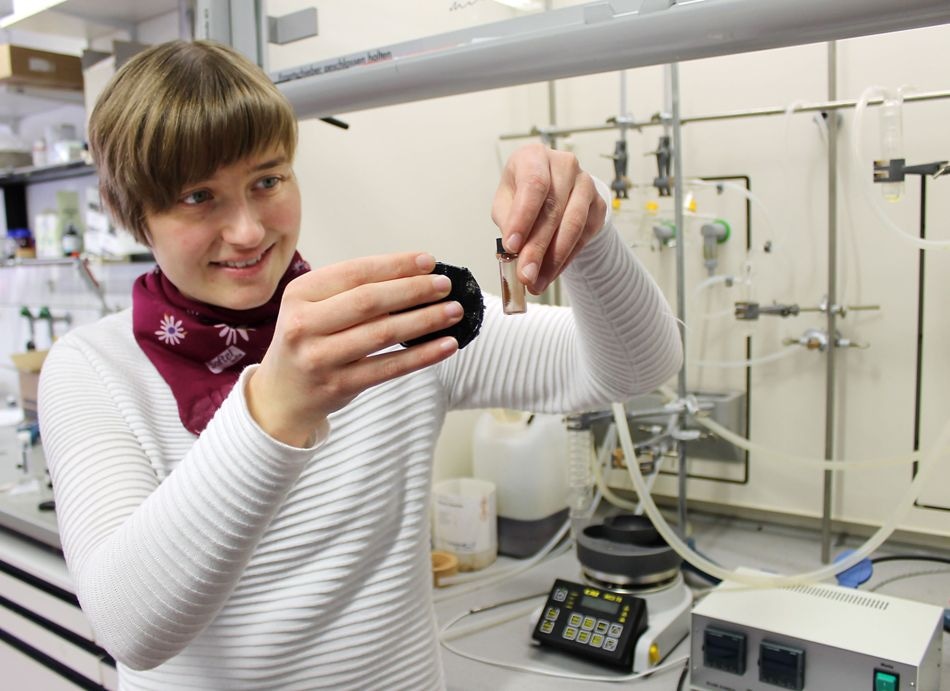Mar 4 2019
Nowadays, nanoparticles finely dispersed in suspensions are employed in several fields, such as in industrial catalysts, in cosmetic products, or in contrast agents for medicinal examinations.
 Sabrina Thomä, lead author of the study, demonstrates the behavior of magnetic nanoparticles. (Image credit: Christian Wißler)
Sabrina Thomä, lead author of the study, demonstrates the behavior of magnetic nanoparticles. (Image credit: Christian Wißler)
For the first time, a team of researchers from the University of Bayreuth has been able to accurately determine the interrelationships of magnetic nanoparticles with the liquid around them, even at the atomic level. It happens to be primarily a question of the crystalline structure of the nanoparticle as to how water molecules in their near surroundings realign themselves. The researchers have reported their study outcomes in the Nature Communications journal.
Based on the theoretical and experimental studies, the research society had long thought that the molecules of a liquid assemble themselves around a solid nanoparticle quite similar to a shell. Within these so-called “solvation shells”—also known as “hydration” shells in the case of water solutions—it is possible to differentiate three to five layers, corresponding to the arrangement of the liquid molecules. However, to date, only information about the number and size of these layers was available.
As a result, the research team working with Bayreuth’s junior professor Mirijam Zobel closely looked at the atomic and molecular structures of these layers in a range of experiments. For this reason, high-energy X-ray measurements were performed using the Diamond Lightsource, an electron synchrotron in Great Britain. The researches focused on magnetic nanoparticles that are extensively used presently in biomedicine, particularly in targeted drug release, as well as in magnetic resonance imaging.
In this way, the scientists found that even the distances that separate the atoms of the water molecules surrounding a nanoparticle can be accurately measured. Thus, it eventually became apparent how water molecules bind to the nanoparticle: in certain cases with the help of dissociative bonds, and in other cases via molecular adsorption.
It was surprising for us that water in the vicinity of tiny magnetic iron oxide nanoparticles arranged itself just like on level iron oxide surfaces on the macroscopic level. We were able to prove that the way in which liquid molecules arrange themselves in the vicinity of a nanoparticle depends primarily on the crystalline structure of the nanoparticle. In contrast, the small organic molecules found on the surfaces of nanoparticles don’t have a direct influence on the arrangement of the liquid molecules.
Mirijam Zobel, Project Leader and Junior Professor, University of Bayreuth.
These are important insights for further research and its applications. Because these organic molecules, with which the nanoparticles are stabilized, serve as anchor points when, in biomedical applications, the nanoparticles are loaded, with antibodies, for example. Hence for the release of such medicinal agents, it is of crucial significance to understand in detail the influence of these molecules on the characteristics and behavior of the nanoparticles.
Sabrina Thomä, MSc, PhD student, University of Bayreuth.
Thomä is also the lead author of the study published in Nature Communications.
Junior professor Mirijam Zobel added that “The study of solvation shells around nanoparticles has meanwhile established itself as a subject in it’s own right all around the world. We’re convinced that the method we have developed can be used more generally. Indeed, in future we will be able to achieve many more exciting insights into ‘Solvation Science’, for example in the areas of catalysts and nucleation.”
Background
In order to identify the structures of the liquid molecules in solvation shells, the research team led by Prof. Dr Mirijam Zobel utilized an X-ray based research technique known as Pair Distribution Function (PDF). A high-performance X-ray diffractometer, which is supposed to improve the use of this technique extremely important to the nanosciences, was recently set up on the Campus of the University of Bayreuth.
Research Funding
The German Research Foundation (DFG) funded this research work at the University of Bayreuth as part of SFB 840 “From particulate nanosystems to mesotechnology.”